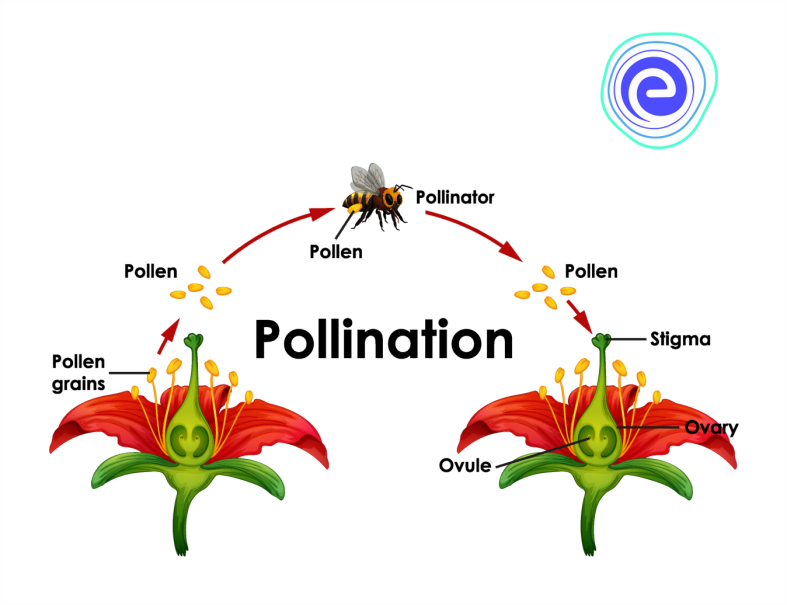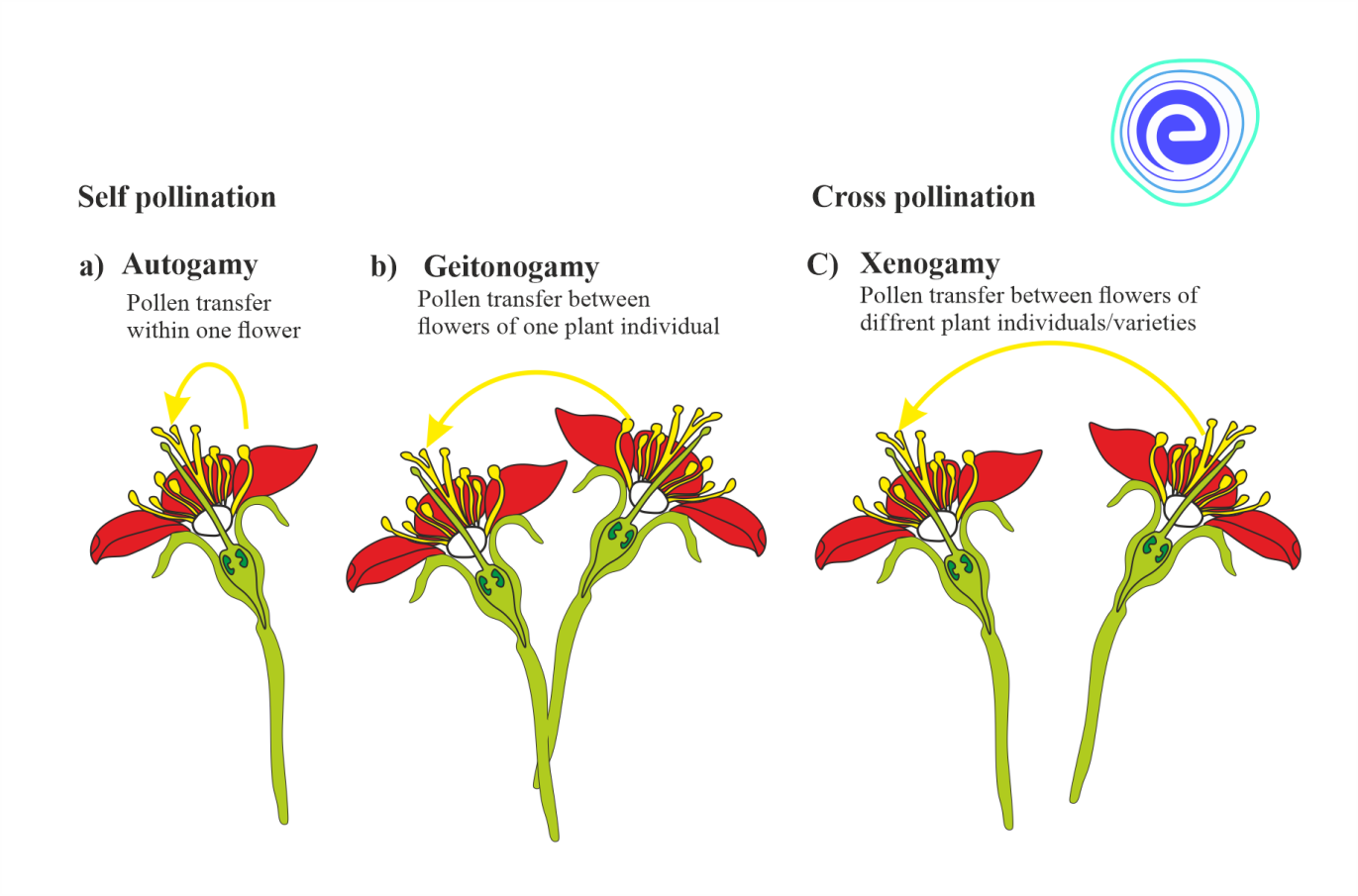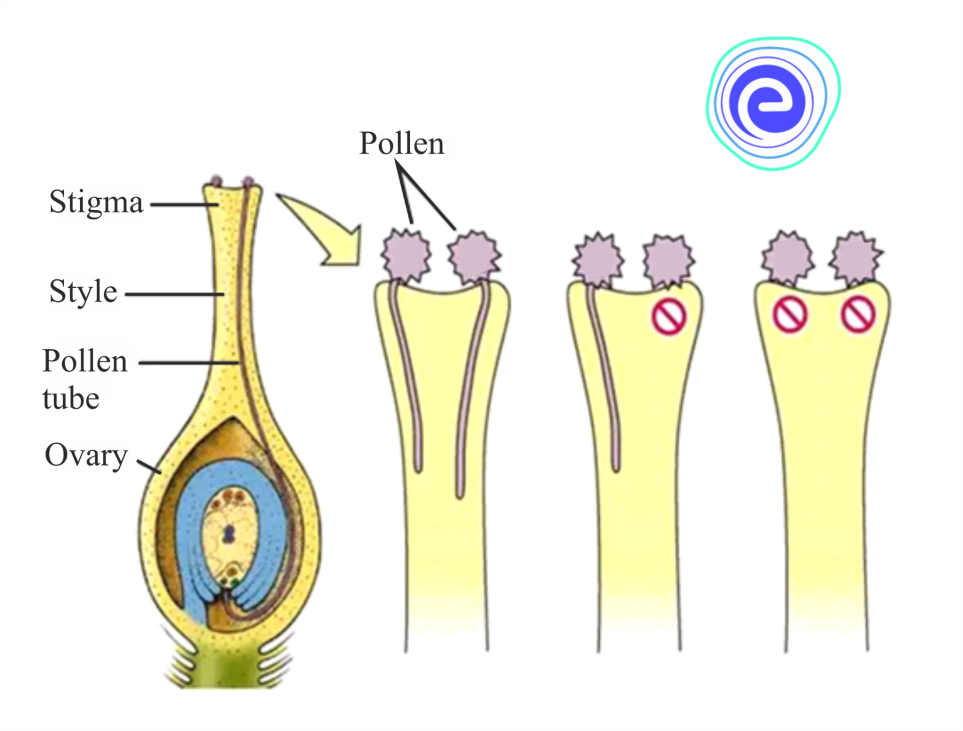- Written By
Shreya_S
- Last Modified 13-04-2025
Pollination and Outbreeding Devices: Definition, Types, Pollen Pistil Interaction
Pollination and Outbreeding Devices: Flowers are symbolic of beauty and have aesthetic, ornamental, social, religious and cultural value. But how are they formed? Let us explain this question with a brief description of the pollination process. The transfer of pollen grains from the anther to the stigma is called pollination.
Self-pollination and Cross-pollination are the types of Pollination that can happen within a flower, between flowers from the same plant, or between flowers from different species. Is self-pollination advantageous over cross-pollination always? What are the devices used by plants to prevent self-pollination? Learn more about the Pollination and Outbreeding Devices, types, pollen pistil interaction and its significance in detail in this article.
Pollination
Fig: Pollination
Pollination is the pre-fertilisation process in which the transfer of pollen grains from the anther to the stigma occurs. In flowering plants, both male and female gametes are non-motile. This necessitates the use of a vector. Pollination is the process of bringing male and female gametes together, which facilitates fertilisation. It can be divided into two types: self-pollination and cross-pollination. Pollination between the same species is required for successful pollination.
Types of Pollination
Self-pollination and Cross-pollination are the types of Pollination that can happen within a flower, between flowers from the same plant, or between flowers from different species. Pollinations can be classified into three categories based on this:
Fig: Types of Pollination
1. Autogamy: It’s a sort of self-pollination in which pollen grains are transferred from the anther to the stigma within the same flower. Autogamy necessitates the opening and exposure of the anther and stigma. Autogamy is only possible if two conditions are met:
a. The synchronisation between the anther and the stigma; when the pollen is released, the stigma should be ready to receive it. Direct contact occurs between the anther and the stigma. Pollination is only between the two if they are close enough.
b. Anther and stigma are visible in chasmogamous flowers. In chasmogamous flowers, the exposed reproductive organs allow for cross-pollination. The anther and stigma are not exposed in cleistogamous flowers, but they are close enough for transfer. As a result, cross-pollination in cleistogamous flowers is nearly impossible. They also don’t require much in the way of pollination.
2. Geitonogamy: It’s a kind of self-pollination in which pollen grains are transferred from the anther to the stigma between various flowers borne on the same plant but at different branches. Despite the fact that it seems to be cross-pollination and occurs with the participation of pollinators, both gametes originate from the same plant.
3. Xenogamy: Transfer pollen grains from the anther to the stigma of genetically different plants of the same species or different species. It is commonly called cross-pollination or allogamy. It brings genetically distinct types of pollen grains to the stigma. Each type has its own advantages, such as xenogamy produces new varieties, and autogamy helps to preserve parental characteristics. Plants have a variety of adaptations to help them complete this task. Furthermore, flowers rely on pollination agents, which can be either biotic or abiotic. Pollinators are biotic and abiotic pollination agents that work together to pollinate plants.
Outbreeding Devices
Self-pollination is common and more prevalent in hermaphrodite flowers, but a succession of self-pollination has a negative effect and leads to inbreeding depression. This leads to homozygous genes as well. As a result, plants have evolved and developed many contrivances to encourage cross-pollination over self-pollination. These are termed Outbreeding Devices.
Factors Contributing Towards Cross-pollination
- Unisexual flower: Cross-pollination is the sole option if a flower is unisexual, meaning it has only one sex, either female or male.
- Non-Synchronisation: Pollination success is dependent on timing. Pollen release and stigma receptivity should occur at the same time. Pollen matures and discharges before the stigma opens, resulting in pollen vitality loss or vice versa. Even though the flower is hermaphrodite, this hinders self-pollination.
- Self-incompatibility: Self-sterility and structural barriers are examples of incompatibility inside a flower (or plant). Self-sterility means that even if pollination occurs, fertilisation is impossible due to pollen growth failure. The height difference between gynoecium and androecium and other features that prevent the stigma from receiving pollen are structural barriers. These are the genetic mechanisms, in a way.
Types of Outbreeding Devices
We have provided the types of outbreeding devices below:
1. Dicliny or Unisexuality: Unisexuality is a method of outbreeding in which the plant produces either male or female flowers. Furthermore, the flower is not hermaphrodite. It effectively prevents self-pollination. The presence of unisexual flowers in plants prevents autogamy but not geitonogamy—E.g. Maize, castor, etc.
2. Dioecy: In this, both autogamy and geitonogamy are prevented in several species like papaya, where male and female flowers are present on different plants, i.e., each plant is either male or female (dioecy).
3. Dichogamy: The stigma and the anther mature at distinct intervals in this Outbreeding device. Dichogamy can be divided into two forms based on the level of maturity:
a. Protandry: The androecium develops first, followed by the gynoecium. Maize plants, for example.
b. Protogyny: The androecium matures first, followed by the gynoecium.
4. Herkogamy: Herkogamy is a naturally occurring situation in which pollen grains encounter a physical barrier that prevents them from entering the ovaries.
5. Self-Sterility: It is a genetic phenomenon of preventing the pollen from fertilising ovules of the same flower by inhibiting pollen germination or pollen, tube growth in the pistil, e.g., Apple, Passiflora, etc. The self-sterile gene can be found in both the ovule and grain.
6. Heterostyly: The stigma and the anther have different levels in this Outbreeding mechanism, preventing the pollen grain from reaching the stigma and pollinating it.
7. Pollen Prepotency: Pollen prepotency occurs when pollen from a different flower grows faster than pollen from the same flower, preventing autogamy.
Pollen Pistil Interaction: Definition
Pollen pistil interaction refers to the series of events that occur from when pollen is deposited on the stigma until the pollen tube enters the ovule. The initial stage or first step in pollen pistil contact is the pollination process, which involves transporting pollen grains from the anther to the stigma of the same flower or from one flower to another.
Pollen Pistil Interaction
Fig: Pollen Pistil Interaction
All pollinations do not result in successful fertilisation since the pistil of a flower must recognise pollen from the same species in order to fertilise it. As a result, the interaction between pollen grains and the stigma must be fully understood. When the pistil accepts compatible pollen, fertilisation events can begin, whereas incompatible pollen is rejected. This relationship, in which a pistil can recognise its pollen, results from long-term pollen pistil interaction and pollen-released chemicals.
The pollen pistil interaction takes place as follows:
1. Recognition of Compatible Pollen
a. Pollination does not ensure that the proper type of pollen grain is transferred to the correct type of stigma.
b. The pistil is capable of determining whether pollen is compatible or incompatible.
c. The stigma allows pollen to germinate if it is the correct type.
d. If the pollen is of the incorrect type, the stigma rejects it, inhibiting germination.
e. The pistil can recognise pollen through a constant dialogue mediated by substances like boron, inositol, and sucrose levels.
2. Growth of a Pollen Tube
a. Pollen grains after getting attached to the stigma absorb water and swell.
b. After compatible pollination, the pollen grain develops a pollen tube through one of the germ pores after suitable pollination.
c. The pollen grain’s contents travel into the pollen tube.
d. The pollen tube passes through the stigma and style tissues before reaching the ovary.
e. The generative cell divides and forms two male gametes inside the pollen tube if the pollen grain is in the 2-celled stage.
f. The pollen tube transports two male gametes from the beginning if the pollen grain is in the 3-cell stage.
3. Entry of Pollen Tube into the Ovule
a. After reaching the ovary, the pollen tube can enter the ovule either through the micropylar end (porogamy) or through chalaza (chalazogamy) or through the funicle or integument (mesogamy).
b. It then enters one of the synergids through the filiform apparatus present at the micropylar end.
c. The filiform apparatus directs the growth of the pollen tube by secreting some chemical substances.
Significance of Pollen Pistil Interactions
Below we have provided the significance of pollen pistil interactions:
- The screening and selection of male gametes during pollen pistil contact is the most important prerequisite for sexual reproduction. As a result, pollen pistil interaction has immense potential for manipulating pollen screening, which is obviously important for pollen quality and compatibility.
- Under typical circumstances, the quantity of pollen grains deposited on the stigma is significantly more than the number of ovules available for fertilisation. As a result, pollen grains compete fiercely with pistils during pollen pistil interaction.
- Only early-germinating pollen with a faster-growing pollen tube, i.e., more vigorous pollen, can resist the rigour of post-pollination competition and fertilisation. As a result of pollen grain competition during pollen pistil interaction, the progeny’s vigour is raised. As a result, this relationship can be considered a major contributory component in flowering plants’ evolutionary success.
- It pertains directly to plant breeding programmes. Through hybridisation, a plant breeder seeks to bring together desirable traits seen in many taxa.
Summary of Pollination and Outbreeding Devices
Pollination is the process of bringing male and female gametes together, which facilitates fertilisation. It can be divided into two types: Self-pollination and Cross-pollination, and it is accomplished via a number of vectors/agents. Pollinations can be classified into three categories based on this: Autogamy, Geitonogamy and Xenogamy. Outbreeding devices includes Unisexuality and Dichogamy.
Pollen pistil interaction is the process of pollen grains from one plant being transferred to the pistil/stigma of another plant, which can be self or cross-pollination. A flowering plant’s pistil is the female reproductive component, while pollen grains are the male reproductive part. Pollen pistil interaction has immense potential for manipulating pollen screening, which is obviously important for pollen quality and compatibility.
FAQs on Pollination and Outbreeding Devices
Q.1. What is pollination?
Ans: Pollination is the biological process of pollen grains being transferred from an anther (a male portion of a flower) to the stigma (female part of the flower). Pollination can be divided into two categories: Cross-Pollination and Self-Pollination.
Q.2. What is self-pollination?
Ans: The predominant method of pollination is self-pollination, which occurs when pollen grains are transferred straight from the anther to the stigma of the same flower.
Q.3. What is cross-pollination?
Ans: Cross-pollination is a sophisticated type of pollination in which pollen grains are transmitted from one flower’s anther to another flower’s stigma.
Q.4. What is pollen pistil interaction?
Ans: Pollen pistil interaction is the process of pollen grains from one plant being transferred to the pistil/stigma of another plant, which can be self or cross-pollination. A flowering plant’s pistil is the female reproductive component, while pollen grains are the male reproductive part.
Q.5. What are the outbreeding devices?
Ans: Outbreeding devices include the following:
1. Unisexuality: The plant could be unisexual, meaning it could have male or female gametes.
2. Dichogamy: In this mechanism, the male reproductive portion (anther) grows at a separate time period than the female reproductive part (stigma), preventing self-pollination.
Know Everything About Pollination Here
We hope this detailed article on Pollination and Outbreeding Devices helps you in your preparation. If you get stuck do let us know in the comments section below and we will get back to you at the earliest.











































